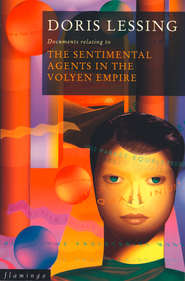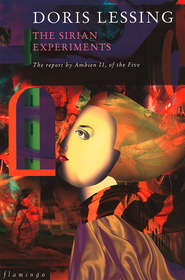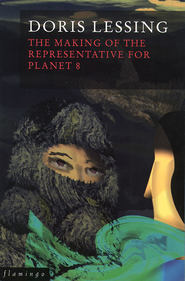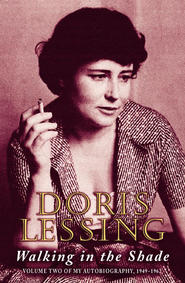По всем вопросам обращайтесь на: info@litportal.ru
(©) 2003-2024.
✖
London Observed
Автор
Год написания книги
2018
Настройки чтения
Размер шрифта
Высота строк
Поля
An elderly man stood with his face to the wire of the bird enclosure. Everything about him was yellowish and dry, like a fungus on an old log, but even his back was full of the vitality of indignation. In the enclosure live flamingos and demoiselle cranes, but he was looking at a fowl, a chicken, a rooster like a sunset in the act of exploding, all iridescent black, gold and scarlet, a resplendent cock who sat on a shiny log raising its wings and crowing, a triumphal shout. ‘You shut up,’ threatened the man through the wire. The cock riposted, ‘Cock-a-doodle-doo,’ or, perhaps, ‘Cock-a-rico,’ and the man said, ‘What are you so pleased with yourself about?’ – at which, ‘Crack-acrack-ooow,’ said the cock, lifting himself a few inches into the air and settling again. ‘Cock-a-rooi!’ ‘Just you shut up,’ said the man. People were looking humorous and pointing him out. He realized this, and turned, squaring his shoulders and glaring. Then off he marched, one-two, one-two, through the trees. The cock shook scarlet wattles and stepped daintily off his log.
Not far away is the paddock where the deer and the goats are kept. At that wire generations of children have learned their parents’ attitudes to the animals. ‘Nasty vicious things, goats,’ says mummy, out of centuries-old memories of goat as Lucifer, goat as witches’ friend, goat driven away under its load of sins, and a little boy says, ‘Nasty goats.’ Or, ‘Darling, look at that lovely little kid.’ But everybody loves the deer.
Deer and goats coexist. The goats are dominant. If goodies are being offered, carrots, apples, bread, then even the big stags will allow themselves to be shouldered aside by goats a third their size. If the goats are replete the stags command the fences. Then come the females, in order of their size and weight and, perhaps, even of their personalities. Behind the deer stand last year’s fawns, while this year’s, who still have their bambi foreheads (Ohhhh, look at the bambis!), stand about at the back watching their elders crowd forward to get titbits. But what the babies like best is to jump into the air on some impulse and then prance madly across the field.
The deer herd disposes itself according to rules we may only guess at. Sometimes the two stags lie among their subjects, regal creatures, holding about them atmospheres from when kings and courts hunted them, and from before that, when shamans were deer, became them in ceremonies going back thousands of years, horns bound to their foreheads. And when did foreheads sprouting horns become ribald?
Sometimes the two stags repose by themselves, or browse side by side, seeming disdainful or indifferent, while the does and fawns lie about or feed together. Sometimes, when the fawns are new, mothers and babies make a nursery place under the enormous oak, while the females too young to breed and the last season’s babies are near, but separate. Last year seven fawns were born, and the year before, seven. These surges of population cannot be accommodated, and one may arrive at the fence among all the little boys and girls who have been given carrot sticks or who have tugged up bits of grass, to find that in the night Fate has struck in the shape of a van, and borne off half a dozen or more of the herd. Where have they gone? Anguishing thoughts, better not pursued. Special friends – vanished. The white doe whose this year’s fawn learned trust for humans from her has gone, though the fawn is still here. And the infant stag, whose buds were just showing? And five of last year’s children? But the opposite also happens. The autumn before last, overnight, instead of seven fawns suddenly there were twelve, for clearly this benign place is regarded by Them, by the Fates, as a satisfactory nursery. Somewhere, in another paddock or forest or zoo, bereft does are looking for their fawns, who are prancing about here.
There are always two stags. Why two? Some lore of deer breeding must order two males for a herd. They are not friends at rutting time. As I write the second stag is sad, is desolate, stands with his head lowered, all by himself, refuses our offerings, and people can be heard, ‘Oh, poor Rudolph, are you sick?’ No, he is not sick. The Master Buck is standing on a little eminence, turning his great antlers about, tossing them, raking the grass with them, emitting grunting roars, and a reek of musk. Second Buck is being hustled away every time he approaches a female, he is being taught every minute of this long October that he is inferior. Sometimes animals emanate depression as humans do.
Soon, those now eroded and splintering antlers will fall off. The two stags will be hornless among their females, to be distinguished from them by their neck and shoulder muscles. And then … then … oh, miracles, the new horns appear, pulsing and velvety buds, and soon become like bars or handles, soft as moss to the touch, and branch, and rush up out of those tender heads and in no time there they are, the new antlers.
Astonishing events may be observed, to be interpreted anthropomorphically or not, according to taste. The summer before last, in July, it happened that we arrived at the fence as a female was giving birth. The bloody bundle dropped from the rear end of a pretty young doe, and she was turning to smell it just as her last year’s fawn, now a half-sized beast, came running. It was demented with jealousy. It knocked over the baby struggling to its feet, and began pursuing the mother around the great paddock. The poor beast, exhausted by the birth, the afterbirth protruding, was harried and hurried all around the field, sometimes staggering and letting out cries of distress. The fawn who had lost its place with her because of this birth would not let her rest nor come near the new fawn. The afterbirth tumbled. At once the crows swooped in to clean up. Meanwhile the two stags who had apparently taken no notice of all this where they lay under the oak got to their feet. First Master Buck, then Second Buck, followed by half a dozen females, walked at their leisure to the fawn lying abandoned in the grass. The two big males stood over the baby. They turned their heads to observe the mother who was still being harried by the jealous pricket. Then Master Buck bent his great head and nosed the baby to its feet. It staggered. It fell. Master Buck again put his nose under the fawn and held it up. It stood, and for longer this time. Then it collapsed. But the males and the females were satisfied. They strolled off to the fence and stood accepting bits of this and that from human friends. When we left half an hour later the mother was still trying to evade her last year’s fawn, hoarsely protesting, and sometimes falling.
Next day she was suckling the baby, but the displaced year-old, the pricket, was close, and she kept moving to keep herself between him, or her, and the fawn.
The goats, too, are not without their dramas. This year two of them were mated, solid matrons, put into a small subsidiary paddock that has its own shed, with a billy goat. This surprised us, for the nannies are so fat, with all the bread and vegetables, that they seem permanently pregnant, but only two were supplied with a mate. When they rejoined the flock in the big field they quickly expanded like inflatables. Until – look! – she’s had a baby. One of them had given birth to a little black and white creature, cocky and cheeky from the first breath. It jumped up the exposed roots of the big oak and stood there showing off, I am king of the castle. Then it ran down and presented a lowered forehead to a big goat, many times its size, who accepted the challenge and carefully put its own forehead down and allowed the baby to butt. The alarmed mother watched the contest but soon could not stand it, and interposed herself between the large goat and the kid who, all sauce and derring-do, kept swaggering up to this big goat and then another, put down its curly forehead and played at butting, anxious mamma always in attendance.
And the second nanny goat? Something must have happened. For a long time she was shut in the enclosure, her swollen udder like bagpipes, looking out at the other mother and the baby. At last her udder subsided. (Was she being milked? Was Nature doing all it ought?) Soon, childless, she was back with the others.
The crows are around all the time, sitting about in the big trees, or on the ground, where they flop and waddle about, searching for what might be in the droppings, or for overlooked bits of bread. The crows would have the eyes out of the fawns’ heads if the mothers were not vigilant. But while mamma goats and the does keep a sharp eye out for crows sidling too close to their offspring, you may very well see on a deer stretched out resting in the grass a crow picking off flies and other insects that plague deer and goats through the long hot months. And we have had two good summers, bringing the insects out in swarms. Thus, in Africa, one may see tick birds picking insects off the hides of animals.
In a week or so the leaves will be down off the trees around the animals’ enclosure, and the crows and the other birds will be visible, many of them, too many, for the mild winters have exploded the bird populations. I counted a hundred crows last week as I threw them bits of bread and they were still flying in from every part of the sky. It seems there is a crow appointed – or self-appointed – to summon the others, for there is a characteristic cry that sounds like ‘Quick, here’s food’. Interesting that during the last severe winter when the birds had such a bad time I put down in my packed-with-ice garden bits of offal for the crows, but they preferred bread. First they ate up the bread, consuming half a dozen loaves in five minutes and then they ate up the meat. O.E.D. Raptores: The name of an order of birds of prey, including the eagle, hawk, buzzard, owl etc. Who, one may assume, would take to sliced white bread if offered it?
So there are the wild animals behind their fence. On the free side humans – and dogs. The deer don’t like it when dogs come nosing up to their fence. Sometimes they see dogs where no dogs are. I have a brown woolly coat which I may bundle under my arm, and then the deer and the crows keep their distance. Clearly they are seeing a brown furry animal. If I wear the coat, filling it out with a human shape, it is all right.
The dogs are teased by the wire. They nose about, trying to remember what their relationships really are with the creatures whose smells start ancestral reminiscences. ‘Come away,’ shout their owners. ‘Come here, Bonzo! Millie! Trixie!’ Every weekend the parks fill with dogs, and this park, an outflank of the Heath, one of the pleasantest, is populated with dogs who have probably spent a sad week shut in houses or even flats, let out, but let out conditionally, off the leash for such a short time and then on sufferance. Dogs who have hardly seen another dog since they were removed from their mother’s teats and their siblings’ play see everywhere big dogs and little dogs, dogs like themselves. ‘Hey, wait a minute – ’ their instincts whisper to them, ‘a dog does not necessarily have to be a human appendage.’ The dogs approach each other, wagging their tails: they sniff bottoms, standing still to be sniffed, or going around in circles while the others nose after infatuating smells – smells that explode in their brains with instructions that contradict everything they have been taught. A dog approaches another with a stick, or with an inviting bark: Come and play, come and chase me. At once a dozen dogs of all sizes are running about and chasing each other, their barks sounding like shouts of joy. These dogs may be descendants of the descendants of house-bound, human-bound dogs, but already they are a pack: you can see the boss dog, and the pack order forming … you can see how they would be left to themselves to forage and chase and fight. And you feel in yourself instincts as old as theirs, when a wolf howling on a hungry winter’s night lifted the hair on your ancestors’ necks. But … here come the owners, here are the humans, they come running to establish order. ‘Come here at once, Bonzo! Gruff! Fifi! Lulu! … Bad dog! To heel!’ The pack falls apart and the dogs return soberly to their owners. ‘Good dog. Good dog!’ And they fall in behind human legs, sniffing at human hands which pat and caress and set down plates of food. But as they go they turn their heads to look back at the other, forbidden dogs. And this look is not only wistful but puzzled.
There is a bear-sized black dog that comes to the café on the hill where I and friends have spent so many happy hours. As it approaches, heads may turn, there may be frissons of alarm from those who have not before seen the beast. The monster dog sits obediently by a chair while its family goes off to get coffee and cakes. The dog, its lolling tongue like a pink plastic tie, seems to smile as it waits. Here they are, his family! They have brought him an ice-cream. He opens jaws like a bear’s … the ice-cream slides from the cone to the great pink tongue, he delicately swallows, and the cone follows. He flops his black furry tail about and lies down. During the very hot days of last summer two enormous black dogs walked into the pond near the bridge, and they sat like bears in arm chairs, lapping at the ripples, smiling while their young mistress called, ‘Come on, Bruno, come on out of there, Baxter!’ But they took no notice, sitting on their backsides in cool mud, their paws flopping in the water under their chins, looking guilty but not enough to bring them out of the deliciousness into the day’s heat. ‘Come on out
Вы ознакомились с фрагментом книги.
Приобретайте полный текст книги у нашего партнера:
Приобретайте полный текст книги у нашего партнера:











